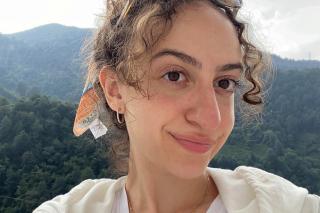How did you become interested in working with focused ultrasound?
I was in Dr. Phillip White's physics class and he would talk about the projects he was working on using focused ultrasound. It interested me into looking into the concept a bit more, in relation to gene therapy. I asked Dr. White if there were any projects similar to this, and he connected me to Dr. Nick Todd, Assistant Professor of Radiology at Brigham and Women's Hospital, who is now my advisor.
I have been performing experiments to examine if a certain method of ultrasound assisting in delivering a gene therapy drug into the brain tissue is safe or effective. I'm working with a therapy for Huntington's Disease that uses gene therapy packaged in an AAV-9 capsid, which would be injected into the bloodstream and using focused ultrasound (FUS), which disrupts the barrier that protects the brain and gets the capsid where you want it to go. My work is determining whether this method is effective and safe.
Tell us about what you have observed at the lab.
I was able to observe two sets of experiments on mice at Brigham and Women's Hospital. I usually read about this stuff, so getting to see it was really cool. There are two injections done on the mice. First, microbubbles are injected which help disrupt the blood-brain-barrier (BBB) with the help of the FUS. Once we get signals that indicate the penetration of the BBB, the gene therapy is also injected. The focused ultrasound causes the microbubbles to oscillate, which means they contract and expand, working to disrupt that barrier, which is really interesting.
The project is a mix of biology and physics, and it's been a great experience for me. I enjoyed the clinical aspect of it because I want to go to med school, and having a chance to look at cells and observe them has been invaluable. The physics part of it is the focused ultrasound and the delivery method, and the biology part is how the cells respond to the focused ultrasound, which allows us to see if the method is safe.
I also read a lot about immunofluorescence, and then had the chance to experiment with it in the lab. I sectioned the brain with a vibratone, then added antibodies. The colors that appear show what cells are expressed, and if two colors were layered on top of each other, that's how we look at colocalization, or to see if the therapy is going into the cells we want it to access — specifically, the neuronal cells, to treat Huntington's.
How has this work impacted your studies at Simmons?
I have to read a lot of research papers for my thesis and I've become more comfortable with what I'm reading. I understand more and I know where to find the data I need for my own thesis. I've done research at Simmons since Freshman year, and this project has given me additional confidence to try new things and improve. I have also learned how to use a few instruments such as the vibratome to section the brain tissue and the microscope at the Harvard Medical Lab, which is different from the ones we have on campus.
I've become invested in this project and enjoy doing it. I plan to apply to medical school this summer, and would like to continue similar research there, too. I've always been interested in working with kids, but since I've begun this research I hope to try to combine my two interests by remaining in the neuroscience field.
Any advice for students interested in getting involved in experiments at the Biomedical Ultrasound Lab?
I would suggest that they read through Dr. White's Biomedical Ultrasound Lab website where all of his projects are listed. If any of his work interests them, reach out to students in the lab. We also have a program where underclassmen can shadow thesis students, to get an idea of how research works at the lab. I would be happy to talk to students about the research I've done!

